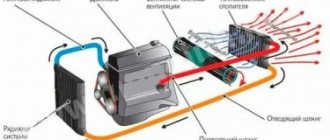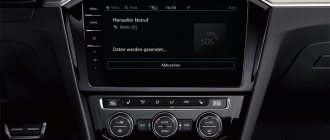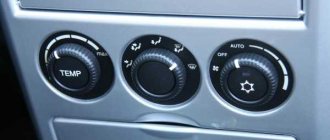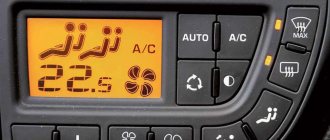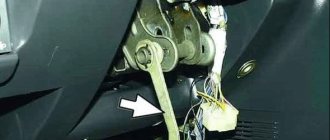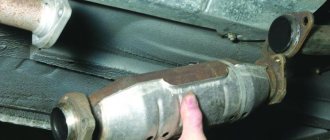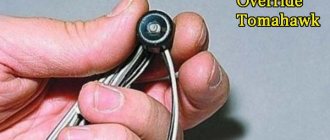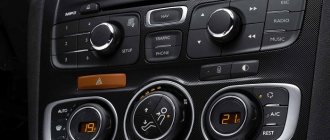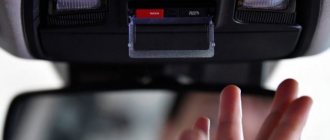On VAZ 2104, 2105, 2106, 2107 and 2108, 2109, 21099 (with a low panel) cars, an econometer is installed in the instrument panel (combination).
Let's try to understand why it is needed and how it works.
Why do you need an econometer on a car?
How does the econometer work?
The econometer works due to the vacuum in the intake manifold of a car engine, which occurs when the pistons move in the cylinders. This is a so-called vacuum gauge that measures the amount of vacuum. A tubular spring is installed inside it, which, when the pressure changes, either compresses or decompresses, moving the associated sector and the arrow of the device. The pressure difference is provided by a rubber tube connecting the econometric fitting and the fitting on the engine intake manifold.
How does an econometer work?
Using the VAZ 2109 car as an example, let’s look at how the econometer works. The device itself is installed in the instrument panel. It is connected to a fitting on the engine intake manifold. Using a rubber tube.
The tube is connected to the econometric fitting from the rear of the instrument cluster
The tube runs under the panel and goes into the engine compartment near the carburetor. There it is attached to a fitting in the intake manifold of the car engine.
The vacuum supply tube to the econometer is connected to the engine intake manifold
TWOKARBURATORS VK -More information on the topic in our VKontakte group
Classic VAZ cars with a carburetor engine were equipped with a device called an economizer. Diagnosing a malfunction and replacing this device with your own hands is quite simple.
Purpose of the economizer VAZ 2107
The full name of the economizer is forced idling economizer (EFS). From the name it is clear that its main function is to regulate the supply of fuel to the combustion chambers in idle mode.
The economizer allows you to save quite good fuel. This is especially true when driving on long descents, where the driver applies engine braking. At such moments, the EPHH does not allow fuel to enter the idle system. This, in turn, not only leads to a reduction in fuel consumption, but also increases traffic safety. The fact is that a car moving downhill in a low gear and constantly braking with the engine is much more stable on the road compared to a car freely rolling down the mountain at neutral speed.
Location of the economizer VAZ 2107
The VAZ 2107 economizer is located at the bottom of the carburetor next to the air filter.
Therefore, before dismantling the economizer, you will have to remove the air filter - there are no other ways to get to the EPHH.
Operating principle of the economizer
The VAZ 2107 economizer consists of:
- solenoid;
- shut-off actuator, made of plastic and performing the functions of a conventional needle valve;
- main idle jet.
If the accelerator pedal is not pressed and the crankshaft rotates at a speed below 2000 rpm, the EPHH is activated and shuts off the supply of the fuel mixture to the idle channel. The economizer is turned on when a signal is sent to it from the vehicle's control unit, connected to a microswitch in the ignition system.
When you press the gas pedal and the crankshaft rotation speed is above 2000 rpm, another signal is sent to the EPHH, turning it off, and the fuel supply to the idle channel is resumed.
Video: operation of the VAZ 2107 economizer
Rosochka and others
Finally, the transparent knob of the gearshift lever with a rose or an insect inside became a real symbol of Soviet auto tuning. This improvement, of course, did not have any functionality, but by the standards of that time the thing was stylish. Of course, this is not the only accessory of this kind. There were also special braids on the steering wheel that car owners made themselves. There were SU stickers that were stuck on the rear window of the car; even the owner (like most Soviet citizens) had never been abroad. There were curtains for the rear window and reflectors in the most unexpected places.
Of course, this hobby also had its opponents. Here is a quote from a Soviet automobile publication in 1978: “The legal side of the issue is touched upon in their letters by Voronezh resident A. Chesnokov, M. Baysik from Sevastopol, N. Chetvergov from Yelets, and other readers. The meaning of their proposals boils down to the fact that if convictions do not work, it is time to use power. They believe that the State Traffic Inspectorate should prohibit the use of decorations and additions that negatively affect traffic safety, and fine them for their use. And in order to have legal grounds for this, it would be useful to include in the text of the traffic rules a clause prohibiting the addition of items to cars that limit visibility or interfere with others.” As you can see, they tried to prohibit motorists from “improving” their car in Soviet times. And, as we can see now, this did not help much.
Signs of malfunction of the VAZ 2107 economizer
There are several typical symptoms of a faulty VAZ 2107 economizer:
- The engine is unstable at idle speed. The diaphragm in the carburetor loses its tightness, and the economizer needle valve begins to partially shut off the fuel supply.
- The engine starts with difficulty, even if it has not yet cooled down.
- Fuel consumption increases by about a third, and sometimes doubles. The latter occurs if the EPHH needle valve becomes completely clogged, hangs in the open position and stops shutting off the fuel supply in a timely manner.
- An increase in fuel consumption is accompanied by a strong decrease in engine power.
- Traces of gasoline splashes appear near the power mode economizer.
The appearance of one or more of these symptoms indicates a high probability of a malfunction of the economizer and the need to replace it.
Device malfunctions and their manifestations
The stability of the engine operation depends on the serviceability of the EPHH, and the failure of this device leads to the following unpleasant consequences:
- Unstable engine idling: spontaneous increase or decrease in speed. In some cases, the power unit simply stalls.
- A sharp increase in gasoline consumption while driving, especially in urban mode.
- A faulty economizer unit, which is installed on the carburetor, does not allow the idle speed to be adjusted correctly.
- The ecometer does not provide correct readings.
The standard engine operation control circuit in this mode does not allow the slightest violation of the system's tightness or its clogging. The main reasons for the failure of this unit are cracks in the membrane or clogging of the channels with solid deposits resulting from the use of low-quality fuel.
Replacing the economizer VAZ 2107
To replace the VAZ 2107 economizer you will need:
- new economizer for VAZ 2107 produced by DAAZ;
- set of open-end wrenches;
- set of socket heads;
- flat screwdriver.
Sequence of work
Work to replace the VAZ 2107 EPHH is carried out in the following order.
- The engine is turned off and cools down for 15 minutes.
- The negative terminal is removed from the battery
- Use a 10mm socket to unscrew the air filter housing mounting bolts. The housing is carefully removed, allowing access to the carburetor.
VAZ 2107 economizer sensor and its purpose
Car owners usually call an economizer sensor an econometer. Econometers of type 18.3806 were installed on the first carburetor VAZ 2107. These devices allowed the driver to estimate the approximate fuel consumption in different engine operating modes - at low speeds, at high speeds and at idle.
Economizer sensor location
The economizer sensor is located on the instrument panel above the steering column next to the speedometer. To dismantle it, simply remove the plastic panel covering the sensor.
Operating principle of the economizer sensor
The economizer sensor is a mechanical measuring device. It is a simple vacuum gauge that monitors the vacuum level inside the engine inlet pipe, since gasoline consumption is associated with this pipe.
The sensor scale is divided into three sectors:
- Red sector. The carburetor flaps are fully open. Fuel consumption is maximum (up to 14 liters per 100 km).
- Yellow sector. The carburetor flaps are approximately half open. Fuel consumption is average (9–10 liters per 100 km).
- Green sector. The carburetor flaps are almost completely closed. Fuel consumption is minimal (6–8 liters per 100 km).
The principle of operation of the sensor is quite simple. If the valves in the carburetor are almost closed, the vacuum in the intake pipe increases, gasoline consumption decreases, and the gauge needle goes into the green zone. If the engine operates at high speeds, the dampers open completely, the vacuum in the pipe reaches a minimum, gasoline consumption increases, and the gauge needle is in the red sector.
What is an econometer in the instrument panel?
On VAZ 2104, 2105, 2106, 2107 and 2108, 2109, 21099 (with a low panel) cars, an econometer is installed in the instrument panel (combination).
Let's try to understand why it is needed and how it works.
What is an econometric device in the instrument panel of VAZ cars?
— Why do you need an econometer on a car?
An econometer device is needed to visually determine fuel consumption by the driver in real time. But not exactly, but approximately - economically or uneconomically.
— How does the econometric device work?
The econometer works due to the vacuum in the intake manifold of a car engine, which occurs when the pistons move in the cylinders. This is a so-called vacuum gauge that measures the amount of vacuum. A tubular spring is installed inside it, which, when the pressure changes, either compresses or decompresses, moving the associated sector and the arrow of the device. The pressure difference is provided by a rubber tube connecting the econometric fitting and the fitting on the engine intake manifold.
The operating principle of the econometer is as follows: the less open the carburetor throttle valves, the higher the vacuum in the intake manifold, the less fuel the engine consumes, the econometer needle is at the end of the scale. And vice versa, the more the carburetor throttle valves are open, the lower the vacuum and the higher the fuel consumption - the econometric needle deviates to the beginning of the scale (yellow zone).
— How does an econometer work?
Using the VAZ 2109 car as an example, let’s look at how the econometer works. The device itself is installed in the instrument panel. It is connected to a fitting on the engine intake manifold. Using a rubber tube.
The tube is connected to the econometric fitting from the rear of the instrument cluster
The tube runs under the panel and goes into the engine compartment near the carburetor. There it is attached to a fitting in the intake manifold of the car engine.
The vacuum supply tube to the econometer is connected to the engine intake manifold
Source
Signs of a malfunction of the VAZ 2107 economizer sensor
Failure of the economizer sensor can be determined by two signs:
- the sensor needle went into the red zone and stopped moving;
- the sensor arrow reached the center of the yellow zone, stopped and began to twitch, not responding to changes in the crankshaft rotation speed.
This behavior of the needle is due to the fact that the teeth on the sensor tube are completely worn out or broken. The sensor needs to be replaced. It cannot be repaired, since there are no spare parts for it on the market.
Replacing the economizer sensor of a VAZ 2107
To replace the economizer sensor you will need:
- new sensor type 18.3806;
- flat blade screwdriver.
How to replace the economizer sensor
The panel that covers the sensor is quite fragile. Therefore, when dismantling it, you should not make much effort. The sensor is replaced according to the following algorithm:
- The panel above the economizer sensor is held on by four plastic latches. The tip of the screwdriver is carefully inserted into the slot above the sensor. Using a screwdriver as a lever, the panel is carefully pulled out until there is a quiet click, indicating that the latch has disengaged.
- Other latches are unfastened in a similar way. Access to the sensor is provided.
Thus, even an inexperienced car enthusiast can replace the forced idle economizer of a VAZ 2107. To do this, you just need to carefully follow the recommendations of specialists.
An economizer is a device that was previously installed on classic VAZ cars. Many drivers believed that this was a completely useless detail that only took up space on the instrument panel and distracted attention. But in fact, this is a useful device; if you slightly adjust your driving style based on its readings, you can reduce fuel consumption by at least 15%. And this is true, because this device monitors one of the most important parameters of engine operation, on which many of its characteristics depend. This is the vacuum in the intake manifold and the air flow directly related to it. That is, in fact, it is an ordinary vacuum gauge, a tube, which is connected to the intake manifold between the throttle valve and the intake valve.
The vacuum in the intake manifold depends on the load, throttle position and speed. If it increases, this indicates that the cylinders are less well filled with air, which means that less fuel is required to maintain a certain mixture composition. That is, by the vacuum in the intake manifold one can judge the fuel consumption. At idle speed with the throttle valve closed, the engine consumes a minimal amount of air. As soon as we open the throttle, air flow increases and the vacuum in the intake manifold drops. At this moment, the economizer needle begins to bow in the direction of increasing fuel consumption. The greater the air consumption and the load on the engine, the less vacuum there will be and, accordingly, the greater the fuel consumption.
If we drive a car uphill or pull a loaded trailer and select 4th gear, then the load on the engine and air consumption can be so great that the economizer needle goes into the red zone. But if we switch to a lower gear, the load will decrease, and the economizer will show us an increase in vacuum in the intake manifold, that is, the arrow will move in the direction of reducing fuel consumption. But of course, it is impossible to accurately determine what fuel consumption is using this device, because it does not take into account the vehicle speed and engine speed. But it is still possible to slightly adjust the consumption by changing the operating mode of the power unit.
In this article we will tell you in detail about the structure of this element of the car and describe in detail how you can repair it yourself.
How to use
With this in mind, the question arises of how to use ECON on Scania climate and other cars. After enabling this option, you can assume that cooling is no longer working. Therefore, the temperature inside the car cannot be lower than outside the car. As for the heater, it continues to function as usual.
What does it mean? If it is 22 degrees Celsius outside and 30 degrees in the car, after turning on the ECON button on the climate control, the shutters open and air from outside enters the vehicle. This happens until the temperature inside drops to the user-set 22 degrees. After this, air access from the street is blocked. As soon as the temperature inside increases above normal again, air access opens again.
Therefore, due to power reduction/compressor shutdown, the temperature in the vehicle cannot drop below street level. In this case, the driver achieves the following results:
- Return of original engine power.
- Fuel economy.
- Reducing noise levels.
- Reduced load on the battery due to less consumption from the compressor.
Service station workers note that you cannot drive with the air conditioning button constantly turned off. In this case, there is a high risk of damage to the stuffing box seals and the appearance of freon etching. It is advisable to use the ECON button in extreme cases, when there is little fuel left in the tank and there is still a long way to go. But in such cases, it’s probably easier to completely turn off the car’s climate control.
Now you know what the ECON inscription on climate control means, what it is, and what it is used for. In simple words, this is a key to turn off / switch to the minimum mode of the refrigeration unit. That is, a kind of analogue of lo/hi. At the same time, the climate system continues to work for heating (if necessary) or brings in air from the street to compare temperatures.
In the comments, tell us if there is such an option in your car, and how you use the ECON button on the climate control.
What is an economizer and why is it needed?
The following types of forced idle economizers are used in cars of the domestic manufacturer VAZ:
EPHH allows excellent gas savings, especially when driving on uneven terrain. During long descents, it suspends the fuel supply through the idle system. This is how engine braking occurs.
This driving mode has a beneficial effect not only on the driver’s wallet, since fuel is consumed more slowly, but such driving is also much safer. After all, when driving on a descent, the car is more confident and safer compared to driving in neutral gear.
Anti-headlights, econometer and other forgotten tuning from the times of the USSR
In addition to the rosette in the gearbox lever, Soviet motorists also knew more technological ways to improve the car’s performance - we recall in the collection 4R.ru
Photo: drive2.ru, Bag
Not everyone in the Soviet Union had a personal car. But in vain many people believe that there was no tuning in the Land of the Soviets. No matter how it is! Handicraft modifications of one’s own vehicle were also popular in Soviet times.
As a rule, such improvements came down to the purchase of special accessories that allowed their owner to look like a seasoned driver in the eyes of others. By modern standards, such accessories are more likely to correspond to the definition of “collective farm”. But now such items are perceived with nostalgia and a sweet smile and can even become a stylish retro element. Let's remember what we bought in the USSR to improve our car.
EPHH device
An economizer is installed on top of the VAZ 2107 carburetor. It is located not far from the air filter and consists of a housing, a shut-off needle that blocks the fuel outlet from the idle system, connected to the diaphragm needle, and an adjusting screw for the “amount” of the fuel mixture.
It is the jet that stops the flow of fuel into the combustion chamber. He does this if 2 important conditions are met - the crankshaft speed exceeds 1800-2000 rpm and the driver’s foot does not affect the accelerator. The EPHH is controlled without human intervention, since its operation is regulated by a small controller connected to the ECU (electronic control unit).
Fan
These days, car air conditioning has become a standard feature, found even on economy models. But in Soviet times, air conditioners were installed only on the most prestigious cars and special equipment. Rare foreign cars don't count. How did Soviet drivers cool down in the heat? That's right, using open windows. But some went further and installed a special fan in the cabin. And it’s okay that such a device was not always easy to use, and it didn’t cool the driver much. The owners of car fans were convinced that they had a “superior comfort” car.
Purpose of the economizer for carburetor power modes
EMR is necessary to saturate the combustible mixture through the carburetor. In this case, the throttle opens and the engine starts running at full speed. In this situation, the engine power increases significantly, plus there is an additional opportunity to increase speed.
Some users install an EMR economizer on the VAZ 2107 carburetor precisely to increase power. But they must be able to do this competently, since while driving the load on the engine increases, which, of course, can lead to engine failure.
The operating procedure of the economizer of power modes of the Solex carburetor
When the car engine is running, chamber throttle 1 remains closed at idle. Therefore, an area of low air pressure appears under the damper. The economizer inlet is open, so the vacuum region extends to the diaphragm inside the economizer. The spring is gradually pulled back in the direction of the housing cover of the EPHH VAZ 2107. At this stage, the ball valve is closed.
After the driver presses the gas pedal, the pressure on the back side of the diaphragm drops, causing the valve to open. Then the fuel from the float chamber enters the emulsion well passing through the nozzle. At this moment, the fuel substance is well enriched with oxygen, so the car is given significant acceleration.
All 2022 Solex economizers come into operation only when the gas pedal is fully depressed.
Massage seat cover
But this accessory is familiar to our people today. A special seat cover made of wood (!) served Soviet citizens as a simple alternative to various lumbar supports and electrically adjustable seats. Still would. It’s no secret that the seats of domestic cars were relatively unsophisticated, and on a long journey the driver’s back inevitably began to ache. However, how well massage capes protected from back pain remains controversial. However, this does not prevent some drivers from using them in modern cars.
Economizer malfunctions
Here are the main symptoms that may indicate that the economizer is not working correctly:
- Fuel consumption has increased;
- Unstable operation at idle;
- The power of the internal combustion engine (ICE) has decreased;
- A warm engine does not start the first time;
- Drops of the fuel mixture appeared in the economizer.
After tuning a VAZ 2107 car, many motorists notice an increase in fuel consumption. You need to understand that after installing the EMR, gasoline consumption may increase, and this is quite normal. And especially when the service life of the internal combustion engine exceeds 5-6 years.
The engine may be unstable at idle due to a malfunction in the control unit. Therefore, voltage is applied to the solenoid, and it is retracted accordingly, affecting the operation of the internal combustion engine. A clogged nozzle or idle channel may be to blame for incorrect engine operation, so it cannot fully pass the mixture.
Anti-glare flashlight
But this device, produced at the Riga Experimental Plant of Mechanization Equipment, can with all responsibility be considered a unique Soviet automobile accessory. We are talking about an anti-dazzle flashlight, or the so-called “anti-headlight”, which was attached to the inside of the windshield. The device created a special light background of blue or violet color, which, according to the creators, should help the driver’s eyes adapt faster after being blinded by the headlights of an oncoming car.
As with other accessories, installing an anti-glare flashlight elevated the owner's status. But the effectiveness of anti-headlights has never been proven! Moreover, even the manufacturer of the device himself indicated in the instructions that the anti-dazzle flashlight is not effective in urban lighting conditions and only works at temperatures above +5 degrees. In general, the thing is, to put it mildly, dubious. But I met in the USSR.
Diagnostics and repair of EPHH
Diagnosing a faulty economizer is not that difficult; you just need to understand how it works and the principle of operation of the economizer. In the future, you will be able to eliminate the main difficulties yourself.
You can replace the EPHH or clean the jet without dismantling the carburetor. The procedure is carried out as follows:
- Carefully remove the air filter.
- Disconnect the power wire from the economizer, after which it should be unscrewed from the housing.
- Remove the jet and thoroughly wash it in kerosene.
- Briefly connect the economizer to the battery. If the drive is more than 5 mm, this indicates normal operation of the device. Otherwise, it will have to be replaced with a new one.
Important!
All repair and diagnostic work must be carried out with a dry carburetor, that is, the fuel must be drained from it.
To independently diagnose a malfunction of the EMR injection VAZ 2107, we suggest you watch the video:
Replacing the economizer
Before starting work, you should collect all the necessary tools, then the replacement process will go much faster. You can make the replacement yourself, just follow these instructions:
- The engine must cool down for an hour before you can proceed with replacement.
- Using a 10 mm wrench, unscrew all the bolts that secure the air filter cover.
- Next, take a size 8 wrench and use it to unscrew the main fixing bolts. You now have access to the economizer sensor and carburetor.
- Now disconnect the connector that powers the micro valve.
- Using a screwdriver, unscrew the 2 bolts securing the EPH sensor.
- Remove the hose from the fitting, then move it to the side (it is advisable to fix it so that it does not interfere in the future).
- There is a spring installed under the panel located behind the sensor. It must be removed carefully, otherwise it may jump out and get lost. After installing the economizer, the sensor and spring should be replaced, as they begin to work worse over time.
- Then the entire system is installed; video tutorials from experienced car enthusiasts will help you with this.
snyatie-paneli-vaz-210754.jpg
Removing the “tidy” of the presented car is carried out in the following sequence:
1. First, you need to prepare the car for operations (to do this, you should review the corresponding material called “Preparing the VAZ 2107 car for repair and maintenance”).
2. Then you need to disconnect the wire on the car from the negative terminal of the battery.
3. After this, use a screwdriver and carefully remove the handles from the stove control levers.
4. The next step is to unscrew the nut that secures the meter reset handle. We remove the nut together with the washer and push the handle into the space that is located behind the instrument panel.
5. Using a thin screwdriver, carefully pry and then remove the screw plug that secures the instrument panel.
6. Using a Phillips screwdriver, unscrew the fastening screw.
7. Carefully remove the “tidy” of the VAZ 2107.
8. Disconnect the cable after the union knurled nut of the car speedometer drive cable has been unscrewed.
9. After this, remove the vacuum supply hose from the econometric fitting.
10. Carefully disconnect the blocks (three colors) of the wiring harnesses.
11. Now you can remove the panel from the car. After this, you can safely perform the following operations:
-replace the backlight lamps;
-if necessary, replace the control lamps.
Installation of the “tidy” should be carried out in the opposite order of its removal.
Video installation of the EPHH system
If you decide to install an economizer on your car yourself, we suggest watching this video. From it you can understand how much work awaits you. We wish you success!
Hello everyone, recently somewhere a couple of days ago I noticed that when accelerating a car, the econometric needle goes into the red zone in all 4 gears, 5th I haven’t tried to accelerate anywhere in the city yet, when I go out of town I’ll definitely check how it performs on the highway at this time I checked everything under the hood for a moment, didn’t find any breaks, maybe the sensor itself is faulty? I went through a bunch of forums on repairing vases and didn’t find anything I needed...
Brake lights
These days, a duplicate brake light on the rear window of a car is an absolutely normal thing. But in Soviet times, not everyone had such lanterns. Therefore, their presence suggested that the owner takes good care of his car. You had to buy (or rather, get!) additional brake lights separately - they were not sold in any car dealerships, and there was no such word then! And after purchasing them, you had to install them yourself by doing the wiring. But then the owner of the car could drive along the roads and be sure that no one would crash into him from behind. Of course, with additional brake lights, each press of the brake was accompanied by a red glow more abrupt than any prohibitory traffic light signal!
